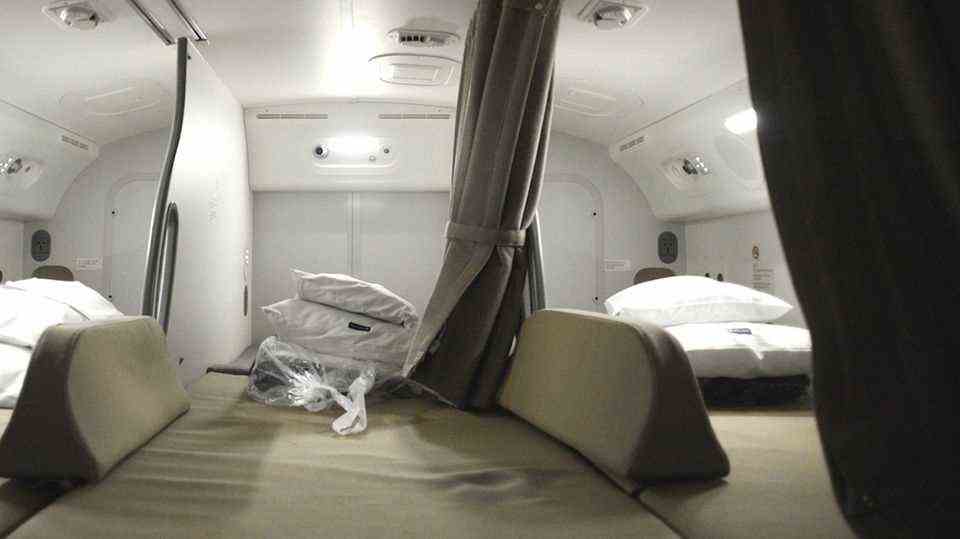Traveling in a sleeping car
Learning from the past: the renaissance of the night trains
The Austrian Nightjet connects Berlin overnight with Vienna, Zurich and Hungary, among others.
© Imago Images
Two new night trains have been running through Europe since December 13th. Last but not least, the climate crisis is making night trains with sleeping cars more interesting again. However, connections that were discontinued years ago were still missing.
At the end of the 19th century, the still world-famous “Orient Express” night train operated by the Belgian entrepreneur George Nagelmackers ran for the first time. With upholstered sofas and decorative elements, the luxury train sponsored by the Belgian king was a novelty. A trip in the cozy sleeping cabin across Europe, for example from Paris to today’s Istanbul, was something special – and only affordable for the rich.
Later, traveling through Europe by rail was also established among the bourgeoisie. Other railway companies now also used the name “Orient-Express” – although the trains did not have the luxury equipment that Nagelmacker’s train once did. According to a spokesman for the Austrian Federal Railways (ÖBB), trains called “Orient Express” ran until 2009.
New connections should now give a boost to travel in night trains again. Since December 13th, such trains will run on the Vienna-Munich-Paris and Zurich-Cologne-Amsterdam routes, as Deutsche Bahn announced at the start of a joint night train offensive by European rail companies. The offer should be extended to further routes in the coming years. “With the Nightjet we are offering a climate-friendly alternative to short-haul flights within Europe,” said Andreas Matthä from the ÖBB board of directors about the new offer.
Driving the night train instead of flying
In view of the climate crisis, more night trains could actually be a good development: The carbon dioxide emissions when traveling by train are lower than when flying. Night trains can replace many a flight – but recently there have been fewer and fewer such connections over the years. “If Deutsche Bahn abolishes the night train, people will fly,” says Joachim Holstein.
For cars, trains and research: these are the tunnels of records
9 pictures
The former night train attendant at Deutsche Bahn and night train activist knows about developments in European night trains at the end of the 20th century. There have been “fantastic routes”, for example from Hamburg via Innsbruck and the Brenner to Verona and Venice or across the Swiss Alps and Cinque Terre to Livorno. Trains went much more often and you could choose longer routes.
Holstein says that as a conductor he traveled a lot on night trains and also used them privately. “Night trains are extremely communicative. The conversations that have taken place in the corridors,” he says. The dining car is also a popular meeting place. You can experience Europe on the night train – not just on the train itself: the air that flows in when the doors are open also changes over the course of the route.

Family-friendly: relaxed travel in a sleeping car
© Imago Images
Martin Randelhoff from the Technical University of Dortmund collected former night train routes for his online blog “Zukunft Mobility”. According to a travel guide for European trains from 1996 and 1997, there were around 100 cross-border night train connections in Europe, according to Randelhoff. In addition, there were around 100 night trains that ran within national borders.
New need for connections
According to a spokesman for the Allianz pro Schiene transport alliance, low-cost airlines and long-distance buses have become competition. The demand for trips in sleeping or couchette cars has decreased. High-speed trains have also resulted in night trains being canceled.
One of them was the night train between Amsterdam and Paris: after the introduction of the French high-speed train Thalys, it was discontinued, as can be read on the Randelhoff blog.
But speed alone is not always the solution, says Bastian Kettner from Verkehrsclub Deutschland. “If I arrive somewhere in the night and then don’t have a connection, the connection doesn’t do me much good either.” It is important to get a connection quickly everywhere – for example to get from Lisbon to Moscow or from Stockholm to Naples.
Not only the connections need a holistic system. If there is no cooperation, it is necessary to buy extra tickets for the individual railway companies, says Kettner. In the event of a delay, it would then be difficult to assert passenger rights for the continuous journey through several countries.
Marion Jungbluth from the Federation of German Consumer Organizations believes there is interest in a good night train offer. The head of the Mobility and Travel team sees a great need to redesign such connections from the consumer’s point of view and with a view to climate protection.
Also read:
– Trans-Europ-Express TEE 2.0: Back to the future with the night train
– Night trains instead of flights: How the corona crisis is accelerating the renaissance of the sleeping car
– Europe starts night train offensive: These German cities play an important role


